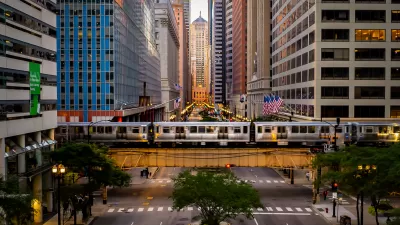In the eighth installment of the Urban Juxtapositions series profiled in Planetizen on January 16, Chuck Wolfe asks if we are using the right language when it comes to densifying urban spaces.
In an illustrated essay that travels from Chicago's Millennium Park to the scaled settlements of Western Iceland, Chuck Wolfe follows up on questions posed early-on in his Urban Juxtapositions series about conceptual approaches to the overlaps, overlays and crossroads of today's city.
The focus? Expectations of "congruity" in urban development:
For many, a dramatic contrast in height, bulk and density is the recipe for “incongruity”. But, in a larger sense, don’t today’s urban centerpieces by definition show the latent “incongruities” of city life?
Wolfe casts "urban blending" and any associated quest for balance as a search for harmony and agreement far more complex than physical appearance, in a comprehensive fashion not limited by ambiguous words:
In other words, the “incongruity” that some would malign as an uneven landscape of height and imbalance, becomes a treasure-trove of irregular, provocative architecture and investment. This investment generates aesthetic and monetary capital to enhance, and not detract from, the public realm nearby.
Offering contrasting examples of classic Icelandic landscapes as instances of "authentic harmony and agreement", Wolfe urges distinction between the balance humans still carry out in the raw landscapes of simpler places and the the vocabulary of balance often sought in in the urban context.
He concludes:
If we remember these nuances in urban setting today, we will better understand that balance and “congruity” are not absolutes, but end-games with multiple meanings, dependent on context, and careful reflection.
FULL STORY: urban blending and the mythical search for 'congruity' in the city

Planetizen Federal Action Tracker
A weekly monitor of how Trump’s orders and actions are impacting planners and planning in America.

Map: Where Senate Republicans Want to Sell Your Public Lands
For public land advocates, the Senate Republicans’ proposal to sell millions of acres of public land in the West is “the biggest fight of their careers.”

Restaurant Patios Were a Pandemic Win — Why Were They so Hard to Keep?
Social distancing requirements and changes in travel patterns prompted cities to pilot new uses for street and sidewalk space. Then it got complicated.

Platform Pilsner: Vancouver Transit Agency Releases... a Beer?
TransLink will receive a portion of every sale of the four-pack.

Toronto Weighs Cheaper Transit, Parking Hikes for Major Events
Special event rates would take effect during large festivals, sports games and concerts to ‘discourage driving, manage congestion and free up space for transit.”

Berlin to Consider Car-Free Zone Larger Than Manhattan
The area bound by the 22-mile Ringbahn would still allow 12 uses of a private automobile per year per person, and several other exemptions.
Urban Design for Planners 1: Software Tools
This six-course series explores essential urban design concepts using open source software and equips planners with the tools they need to participate fully in the urban design process.
Planning for Universal Design
Learn the tools for implementing Universal Design in planning regulations.
Heyer Gruel & Associates PA
JM Goldson LLC
Custer County Colorado
City of Camden Redevelopment Agency
City of Astoria
Transportation Research & Education Center (TREC) at Portland State University
Camden Redevelopment Agency
City of Claremont
Municipality of Princeton (NJ)





























